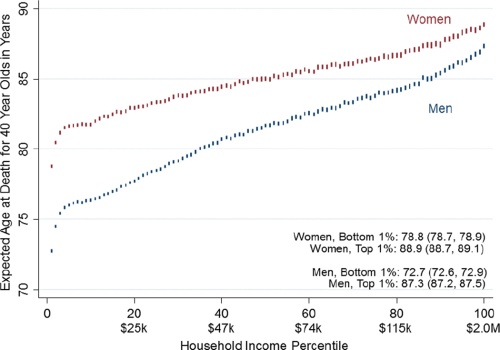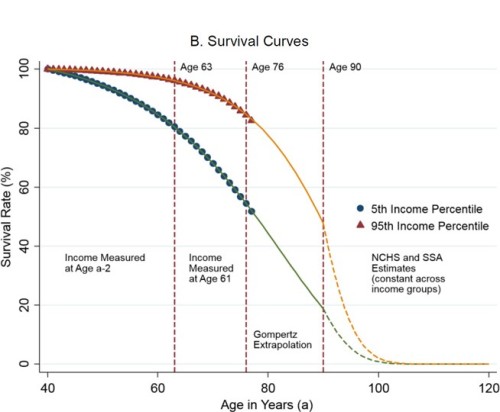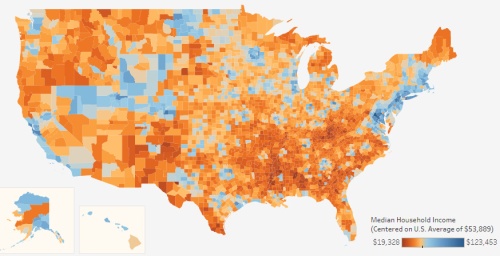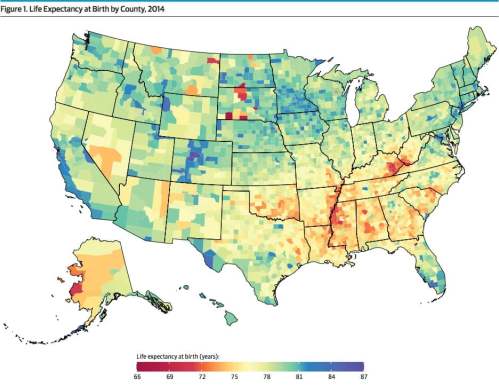Undoubtedly – by almost 15 years according to a landmark National Institutes of Health study which looked at over 1.4 billion de-identified U.S. tax records from 1999 – 2014, comparing them to associated death records from the Social Security Administration. According to the National Center for Health Statistics (May 2017), life expectancy at birth increased from 72.6 to 78.8 years between 1975 to 2015. This improvement has been attributed to dramatic advances in medical technologies as well as resources devoted to enhanced public health and education programs. As impressive as this is, whether you are rich or not actually appears to play a greater role in how long you will live.
This is obviously a very complicated analysis, compounded by almost innumerable variables such as local health behaviors (e.g., prevalence of smoking, access to quality food and housing), strength of local governmental assistance programs, societal stress, environmental conditions. Interestingly, the study concluded that the quantity and quality of local medical care was not a significant factor when accounting for such dramatic disparity. The pattern that emerged most forcefully in the data was that proximity to wealthy cities with both high levels of government spending and quality education accounted for higher life expectancy rates across all economic strata.
Each 5-point increase in percentile consistently added about 0.8 years of additional life expectancy, notwithstanding that the absolute change in income could be dramatically different. For instance, going from the 95th percentile to the 100th was an increase in income from $224k to $1.95 million, yet going from the 15th to the 20th percentile was only an increase in income from $14k to $20k.

Shockingly, men in the lowest 1% of household income were expected to survive until only 72.7 years of age while men in the top 1% enjoyed a life expectancy of 87.3 years. Men in the lowest percentile had a life expectancy equivalent to the mean expectancy for those in Pakistan and Sudan, while at the other end of the spectrum, those men had the highest expectancy of all countries measured. The wealthy had relatively higher survival rates well into their 70’s while the poor immediately experienced deteriorating survival rates.

The Federal Reserve Board recently estimated that 40% of all Americans would not be able to afford an unexpected $400 expense, an incredibly stressful condition to be in. Furthermore, 25% of the respondents shared that they skipped a necessary medical procedure, while 20% were not able to cover their monthly expenses. Axios reported that total U.S. 2018 healthcare costs were $3.65 trillion or $11,121 per person. As healthcare spending in the U.S. converges on nearly 19% of GDP, the Labor Department recently published data that showed almost 8% of all consumer expenditures is for healthcare, nearly 5.5% of which is just for insurance. Obviously, the burden of healthcare costs is significant and may account for why Gallop polling data points to nearly 70% of all Americans in favor of a single payor model.
The distribution of wealth in the country is uneven and relatively concentrated in mostly a number of coastal counties and the Upper Midwest. The disparity can be as much as a 10x difference, although even within counties there are obvious differences by neighborhood.

Interestingly, when looking at life expectancy by county, that map (below) shows a similar distribution as the median household income map above. The counties with lower life expectancies have been particularly hard hit by “diseases of despair” such as those associated with substance abuse and suicide. The Institute of Health Metrics and Evaluation identified 21 less affluent states where the risk of “dying young” from those conditions was particularly high. According to Axios, drug overdose, suicide and alcohol abuse accounted for over 150,000 fatalities in 2017, contributing to a disturbing decline in the life expectancy rate in 2016 to 78.7 years.

Concurrent with this slight decline in life expectancy has been the accelerated wealth inequality in the U.S. Over the last ten years, more than $30 trillion of household wealth was generated, in large measure due to the bull market in public equities. Surprisingly, though, the median American household net worth declined by 34% over that same period. At the end of 2018, household net worth was $104.3 trillion according to the Federal Reserve, which was down 3.4% in the last quarter. Interestingly, the household savings rate was 6.7% in 4Q18.
Economists and entrepreneurs are now focusing increasingly on the “Longevity Economy” given there are already 600 million people over 65 years old worldwide. Americans over 50 years old accounted for nearly $8 trillion of economic activity in 2015. Innovative new forms of housing, consumer products and healthcare technologies will need to be developed to serve their unique needs. Much of this innovation will likely target a relatively more affluent customer base.
An October 2018 Pew Research Center survey showed that 43% of respondents thought that the rich got that way by working harder, while 42% felt that they simply had more advantages. And while the life expectancy / wealth relationship is an incredibly complicated issue and will require exceptional leadership to even begin to address, one conclusion in the data is very clear: communities that enjoy greater levels of residential economic integration demonstrate overall greater life expectancies across all strata.
BREAKING NEWS: The Trump Administration today announced dramatic cuts today to Medicaid entitlement programs as part of the proposed 2019 budget.

Is this causative or correlative. Meaning that a number of folks who live in the US who make less than 65K per annum may be making a series of poor life choices, which in turn impacts their health and life expectancy – including activities with regard to substance abuse. Are the life choices regarding substance activity and otherwise creating the low earnings you are seeing in your numbers and also impact their mortality rate?
Great piece! Now we must understand the mechanisms that drive the correlation between wealth and longevity, be it access to care, access to healthy lifestyle options, lifestyle decisions, environmental (including pollution, violence), other factors that in the US correlate with wealth (e.g., education level, ethnicity), stress/self-perception of wellbeing, etc.